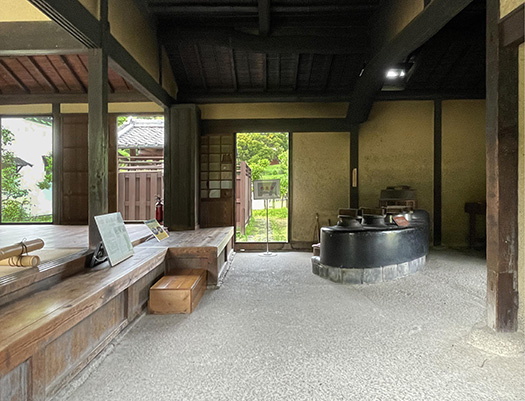

江戸期の「駅逓」とでもいえる用途の建築、旧臼井邸。
一種の「公共建築」という方がその機能を表している。
上の写真の、庇が張り出した半外半内的な空間などは
一種の「プラットホーム」というような機能空間だとわかってくるし、
その下の写真は、多くの人が参集する待合土間空間とも思える。
実際に1700年代初頭の建築年代にはそのように使われたに違いない。
奈良県の中部の高取藩の家臣が「公用」で出掛けるとき
下命に即しての公務出張に際して、このプラットホームで人馬の用意を待ち
そして整った人馬を従えて旅立っていった。
広大な土間空間では道中での旅行食などを用意したり
随行の人馬が荷物を整理点検しているような光景が浮かんでくる。
出立する人々を「見送る」人も参集して、往来の場であったことだろう。
この建築は高取藩の「公用」としてが主要目的だったけれど、
そういう公務機能支援を町方として支配者から仰せつかる見返りとして
通常の庶民の移動交通についてのサービス役務も果たしていたことが
容易に想像することができる。
多くの荷物を馬で運んで移動する社会ニーズを業務として担っていた。
やがてこうした機能性空間は現代の駅空間に変容していくのだろうけれど
そのネイティブな空気感が漂っているように思われる。
石高は「管理している」地域をすべて含めても10万石程度規模の
城下町なのでそう大きな役務が発生したとは思えない。
現代で言えば人口10万人程度の地方駅舎と類推可能だろうか。
ただ、京都と紀州を結び平野部の最後の場所でここからは山道の地域性。
往来の結節点としてそこそこの活気が想像できる。
出会いと別れ、というような人間ドラマの舞台をそこに想像することができる。
わたしも多くの数百年単位の古建築を見て来たけれど、
こういう機能性空間ははじめてのような気がする。
これは300年前くらいの空間だけれど、
考えて見ると日本史では数多くの「合戦」があり全国規模の往来記録もある。
源平合戦期などが象徴的に「移動交通」を実感させるけれど
とくに「兵站」ということではこのような街道・宿場・通運機能が必須。
列島社会では神武東征以来、壬申の乱などの時期から
活発な「東西交通」の痕跡を発見することができる。
東北地域の支配権を確立した藤原清衡は政権発足と同時に支配地を縦断する街道に
里標の設置を命じているし、徳川家康も関東に幕府を開くと同時に
京大阪との交通路の整備整頓を命じている。
その時代の社会の中で、移動交通の手段の整備というのは常にキモだった。
建築にはこういう空気感を追体験する機縁があると思う。
English version⬇
The former Usui Residence is a building that can be described as an “ekimae” (station delivery service) of the Edo period.
The function of the building is better described as a kind of “public architecture.
The half-outside, half-inner space with overhanging eaves in the photo above is a kind of functional space like a “platform.
The photo below shows a space that is a kind of “platform”.
The photo below shows a space with an earthen floor where many people gather to wait.
In fact, it must have been used as such during its construction period in the early 1700s.
When a vassal of the Takatori clan in the central part of Nara Prefecture went on an “official” trip
When a vassal of the Takatori clan in the central part of Nara Prefecture went on an official business trip, he would wait for his men and horses to be ready on this platform.
Then, they departed with their horses and men.
The vast earthen floor space was used to prepare food for the journey and to check the luggage of the accompanying men and horses.
I can imagine the scene of the accompanying horses and men sorting and inspecting their baggage.
People who were “seeing off” departing travelers also gathered here, and it must have been a place of traffic.
Although the main purpose of this building was for “official use” of the Takatori clan
In return for being asked by the ruler to support the official functions of the Takatori clan
It is easy to imagine that the building was also used to provide transportation services for the common people.
It is easy to imagine that the clan was also responsible for providing transportation services for the common people.
The township was responsible for the social needs of the people to carry a large amount of goods by horseback.
Eventually, these functional spaces would be transformed into modern station spaces.
the native atmosphere of the area seems to be in the air.
Even if we include all the areas “managed” by the castle town, the total amount of stone value is only about 100,000 koku.
It is hard to believe that such a large scale of government service occurred in this castle town.
In modern times, it would be analogous to a regional station house with a population of about 100,000.
However, it is the last place on the plain connecting Kyoto and Kishu, and from here, it is a mountainous area.
As a nodal point for traffic, one can imagine a certain amount of activity.
We can imagine a stage for human dramas such as encounters and partings.
I have seen many old buildings that are several hundred years old, but this is the first time for me to see such a functional space.
I have seen many old buildings that are several hundred years old, but I have never seen a functional space like this.
This space is about 300 years old.
When you think about it, there have been many “battles” in Japanese history, and there are records of traffic on a national scale.
The Gempei War period, for example, symbolically evokes the sense of “mobile transportation.
Especially in terms of “logistics,” such highways, post stations, and transportation functions are indispensable.
In the archipelago, since the Jinmu Expedition and the Jinshin Rebellion, there have been traces of active “east-west transportation”.
Since the Jinmu-Tokugi expedition, traces of active “East-West transportation” can be found in the archipelago society.
Fujiwara no Kiyohira, who established control over the Tohoku region, ordered the installation of “ri-markers” along the roads that traversed the area he controlled as soon as he assumed power.
Tokugawa Ieyasu also ordered the establishment of transportation routes to and from Kyoto and Osaka at the same time he established the Tokugawa Shogunate in the Kanto region.
Tokugawa Ieyasu also ordered the construction of transportation routes to and from Kyoto and Osaka at the same time he established the shogunate in the Kanto region.
In the society of that era, the maintenance of means of transportation was always a key element.
I believe that architecture provides an opportunity to experience this kind of atmosphere.
Posted on 7月 16th, 2022 by 三木 奎吾
Filed under: 住宅マーケティング, 歴史探訪







コメントを投稿
「※誹謗中傷や、悪意のある書き込み、営利目的などのコメントを防ぐために、投稿された全てのコメントは一時的に保留されますのでご了承ください。」
You must be logged in to post a comment.